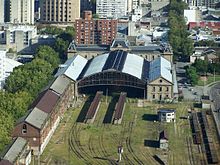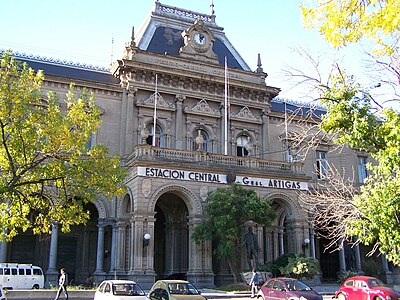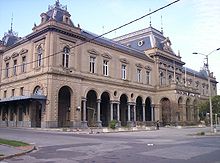Montevideo Estación Central General Artigas
The Estación Central General Artigas station was the main train station of the Uruguayan capital, Montevideo . After various, smaller train stations in the vicinity of today's train station, the construction of the Italian architect Luis Andreoni was put into operation on July 15, 1897. As a result of the “ Plan Fénix ” urbanization concept , the station was shut down on March 1, 2003 and replaced by a much smaller station 500 meters further north. The listed building is still unused today.
history
predecessor
Montevideo received its first train station in 1871 after the first Uruguayan railway line between Las Piedras and Bella Vista (today Lorenzo Carnelli train station , now incorporated into Montevideo) was extended to downtown Montevideo on July 16. The first railway line itself had already been opened two years earlier, on January 1, 1869, between the two stations. The station was at the intersection of Sur-Oeste de Orillas del Plata (now Calle Galicia ) and Calle del Río Negro .
The first building was replaced in 1874 by a two-storey new building on Calle Río Negro (between today's Calle La Paz and Calle Valparaíso ), as the railway line was only in its final position in that year. The station had a freight platform and a single platform for passenger trains to today's Calle Paraguay .
Opening of the new building

On December 14, 1891, the station building was completely destroyed by fire. Thereupon the Ferrocarril Central decided to build a new train station in the same place. The railway company commissioned the architect Luis Andreoni with the construction. Work on this began in 1892, and on August 27, 1893 the foundation stone for the new station building was laid. Andreoni designed a terminal station based on the European model in an eclectic style with a crossbar and two station wings parallel to the tracks. The 47 meter by 120 meter hall roof of the station was not completely glazed, but mostly covered with zinc plates. On June 23, 1897, the Ferrocarril Central ceremoniously opened the station, and the railway company started operating on July 15 of the same year. In 1930 the ticket offices, which at the time were still outside the station on Calle Río Negro , moved into the large station concourse after a large restaurant had moved out.
On January 31, 1949, the nationalization of the Uruguayan railways was commemorated by a memorial plaque in the station, before this 1952 with the association of Ferrocarril Central del Uruguay (FCCU) and Ferrocarriles y Tranvías del Estado (FTE) to the Administración de Ferrocarriles del Estado (AFE ) could be completed. In 1955, the Uruguayan government called the station, which until then simply Estación Central was named in honor of the national hero of Uruguay, José Artigas , in Estación Central José Artigas to. In 1974 this was changed to Estación Central General Artigas .
With the decision 1097/975 of July 8, 1975, the station was classified as a national monument ( Monumento Histórico Nacional ), it was given the number 019-139.
With the start of express train operations using the Ganz Mavag trains, the platform hall was also modernized in 1977.
Further development through to closure
After all passenger trains were discontinued on January 2, 1988, the AFE used the platform hall for various exhibitions, while the administrative offices and the freight terminal continued to be used as usual. After the first special trains ran to different parts of the country in 1991, a suburban railway hull operation began on August 25, 1993 between the main station and 25 de Agosto .
In 1996, part of the goods terminal was sold to ANTEL , which built parts of the complex around the Torre de las Comunicaciones on this site . In 1998 the state sold the station building to Banco Hipotecario del Uruguay , as the entire area was part of the new Plan Fénix . This Fénix plan envisaged an urbanization concept for the northern part of the center around the main train station, the building was to be converted into a cultural shopping center, and parts of the existing goods terminals into a large supermarket. Since the plan did not include any rail traffic in the main station, construction of a replacement station began in 1999, 500 meters further north of the station. After numerous construction defects and delays, the replacement station with three tracks was able to start operations on March 1, 2003. Since then, the old main train station has been out of service and has no siding. Since the bank withdrew AFE's permission to use the station in 2003, the AFE administration also had to move out. At the same time, the closure brought with it numerous disadvantages. On the one hand, the Uruguayan railway traffic lost more than 100,000 passengers per year due to the considerably greater distance to the center, and new (rented) premises had to be found for the administration and freight traffic to the Uruguayan capital has been delayed since then because there is no longer enough space - and unloading areas for the freight wagons. Due to the Uruguayan banking crisis in 2002 , the "Plan Fénix" has not yet been completed.
In February 2007 the station was reconnected to the national rail network. At the end of 2008 the station apron was built in order to be able to take up traffic in the direction of the neighboring port. To this day, a Uruguayan civil association is fighting for a reactivation of the train station, but has not yet been able to get through with their request. Various plans to reuse the station, including as the seat of the Uruguayan Congress of Intendent, have so far failed. The neglect of the former main train station of the Uruguayan capital is seen from many sides as symptomatic of the state of the rail network in Uruguay.
literature
- Guía Arquitectónica y Urbanística de Montevideo. 3. Edition. Intendencia Municipal de Montevideo et al., Montevideo et al. 2008, ISBN 978-9974-600-26-3 , pp. 89, 157.
Web links
- [1] [2] Photos of the train station from the 1950s / 1960s
- Side of the citizens' movement that is fighting for a reopening of the train station (Spanish)
Individual evidence
- ↑ a b Fernán R. Cisnero: El monstruo lento , [The slow monster], El País , September 19, 2009
- ↑ Marcelo Bustamante: Vieja estación de AFE servirá de sede del Congreso de Intendentes , [Old AFE train station will be the seat of the Intendent's Congress], La República , September 20, 2008
- ↑ Nueva vida para edificio de Estación Central , [New life for the main train station building], El País , August 6, 2009
Coordinates: 34 ° 54 ′ 0.8 ″ S , 56 ° 11 ′ 40.4 ″ W.




